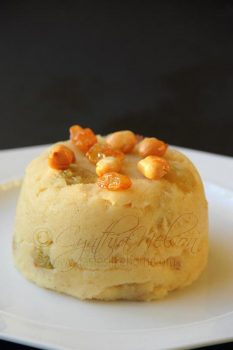 Whenever there is a holiday marking a religious festival, I always try to make something that keeps me connected to home.
Whenever there is a holiday marking a religious festival, I always try to make something that keeps me connected to home.
This recipe is made just like Parsad but instead of using regular all-purpose flour, I have replaced it with semolina flour. Semolina flour is made from durum wheat. It is sturdier than flour wheat and when ground to a flour there is a very fine grain. Yellow in colour from the high concentration of carotenoids (the same compounds that give carrots their bright colour), semolina, holds up to long cooking. It is a flour widely used to make dried Italian pasta as well as Moroccan couscous. The flour makes excellent breads too, and yes, you can also make cake with semolina flour.
The use of semolina to make this version of Parsad gives it a pudding-like texture.
INGREDIENTS

Photo by Cynthia Nelson
½ cup ghee
1 ½ cups semolina flour
1 cup sugar
1/3 cup raisins, rinsed and pat dry
1 teaspoon ground green cardamom (elaichi)
1 ¼ cups whole milk
3 ½ cups boiling water, divided
(First usage: 1 ¼ cups to dissolve sugar)
(Second usage: 2 ¼ cups to cook mixture)
Fried nuts for garnish (optional)
SPECIAL EQUIPMENT
1 karahi (Indian-style wok) OR deep heavy-bottomed
pan with sides 4 – 5 inches high
1 whisk
1 wooden spoon
DIRECTIONS
- Add ghee to karahi and place over medium until melted and very hot but not smoking.
- Add semolina flour to hot ghee and keep whisking until all the ghee is absorbed.
- Turn the heat to low and continue to stir the mixture; the mixture will start to get wet (as if liquid has been added to it) as it continues to cook. This process takes 15 – 20 minutes. Stir in the raisins.
- Dissolve sugar in 1 ¼ cups of boiling water and add immediately to the mixture; be careful and watch out for the steam.
- Keep stirring, this time with the wooden spoon; at this stage you will notice the mixture coming together.
- Add milk, the remaining 2 ¼ cups of boiling water and cardamom and stir.
- Keep stirring until all the liquid is incorporated and there are no lumps (the heat should still be on low, this is important so that the parsad does not scorch).
- Stir until the mixture comes away cleanly from the pan and attempts to form a ball; this can take any where from 10 to 15 minutes.
- Serve warm or at room temperature in half-cup servings.
NOTES
- At direction # 8, I found that it was not necessary to stand in front of the stove stirring all the time. Once the heat is properly regulated so that the mixture does not scorch, you can check on it and give it a proper stir at 5-minute intervals.
- Peanuts, cashew, almond or pistachio nuts can be used for garnish.









